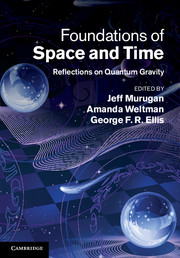Book contents
- Frontmatter
- Contents
- List of contributors
- 1 The problem with quantum gravity
- 2 A dialogue on the nature of gravity
- 3 Effective theories and modifications of gravity
- 4 The small-scale structure of spacetime
- 5 Ultraviolet divergences in supersymmetric theories
- 6 Cosmological quantum billiards
- 7 Progress in RNS string theory and pure spinors
- 8 Recent trends in superstring phenomenology
- 9 Emergent spacetime
- 10 Loop quantum gravity
- 11 Loop quantum gravity and cosmology
- 12 The microscopic dynamics of quantum space as a group field theory
- 13 Causal dynamical triangulations and the quest for quantum gravity
- 14 Proper time is stochastic time in 2D quantum gravity
- 15 Logic is to the quantum as geometry is to gravity
- 16 Causal sets: discreteness without symmetry breaking
- 17 The Big Bang, quantum gravity and black-hole information loss
- 18 Conversations in string theory
- Index
- References
11 - Loop quantum gravity and cosmology
Published online by Cambridge University Press: 05 August 2012
- Frontmatter
- Contents
- List of contributors
- 1 The problem with quantum gravity
- 2 A dialogue on the nature of gravity
- 3 Effective theories and modifications of gravity
- 4 The small-scale structure of spacetime
- 5 Ultraviolet divergences in supersymmetric theories
- 6 Cosmological quantum billiards
- 7 Progress in RNS string theory and pure spinors
- 8 Recent trends in superstring phenomenology
- 9 Emergent spacetime
- 10 Loop quantum gravity
- 11 Loop quantum gravity and cosmology
- 12 The microscopic dynamics of quantum space as a group field theory
- 13 Causal dynamical triangulations and the quest for quantum gravity
- 14 Proper time is stochastic time in 2D quantum gravity
- 15 Logic is to the quantum as geometry is to gravity
- 16 Causal sets: discreteness without symmetry breaking
- 17 The Big Bang, quantum gravity and black-hole information loss
- 18 Conversations in string theory
- Index
- References
Summary
“It would be permissible to look upon the Hamiltonian form as the fundamental one, and there would then be no fundamental four-dimensional symmetry in the theory. One would have a Hamiltonian built up from four weekly [sic] vanishing functions, given by [the Hamiltonian and diffeomorphism constraints]. The usual requirement of four-dimensional symmetry in physical laws would then get replaced by the requirement that the functions have weakly vanishing P.B.'s, so that they can be provided with arbitrary coefficients in the equations of motion, corresponding to an arbitrary motion of the surface on which the state is defined.” P. A. M. Dirac, in “The theory of gravitation in Hamiltonian form,” Proc. Roy. Soc. A 246 (1958) 333–43.
Introduction
In its different incarnations, quantum gravity must face a diverse set of fascinating problems and difficulties, a set of issues best seen as both challenges and opportunities. One of the main problems in canonical approaches, for instance, is the issue of anomalies in the gauge algebra underlying space-time covariance. Classically, the gauge generators, given by constraints, have weakly vanishing Poisson brackets with each other: they vanish when the constraints are satisfied. After quantization, the same behavior must be realized for commutators of quantum constraints (or for Poisson brackets of effective constraints), or else the theory becomes inconsistent due to gauge anomalies. If and how canonical quantum gravity can be obtained in an anomaly-free way is an important question, not yet convincingly addressed in full generality.
- Type
- Chapter
- Information
- Foundations of Space and TimeReflections on Quantum Gravity, pp. 211 - 256Publisher: Cambridge University PressPrint publication year: 2012



